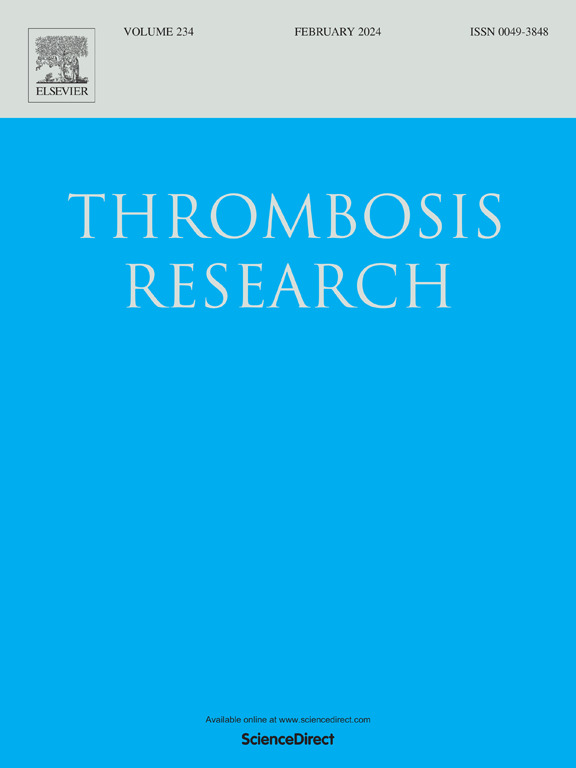癌症患者缺血性脑卒中的发生率和危险因素:一项回顾性观察性研究
IF 3.4
3区 医学
Q1 HEMATOLOGY
引用次数: 0
摘要
癌症患者发生缺血性中风的风险较高,这可能会中断癌症治疗并恶化生存结果。然而,这一人群中风发病率和危险因素的流行病学数据仍然有限。方法:我们对2007年至2020年在大阪大学医院登记的35,862例癌症患者进行了回顾性观察研究。在癌症诊断后对患者进行为期一年的随访,以评估缺血性卒中的累积发病率,并将死亡作为竞争风险。使用Fine和Gray竞争风险模型评估风险因素,计算亚分布风险比(SHRs)及其95%置信区间(ci)。结果在研究期间,188名患者发生了中风。其中,缺血性卒中是最常见的类型,发生143例(76.1%),其次是脑出血38例(20.2%)和蛛网膜下腔出血7例(3.7%)。缺血性脑卒中1年累计发病率为0.42%。在多变量分析中,缺血性卒中的独立危险因素包括年龄较大(调整后SHR为1.01,95% CI为1.00-1.03)、高血压(1.59,95% CI为1.10-2.30)、血脂异常(1.60,95% CI为1.09-2.36)、房颤(2.42,95% CI为1.54-3.81)和晚期(1.74,95% CI为1.12-2.70)。肿瘤诊断时白细胞计数(≥11000 /μL)和血小板计数(≥350000 /μL)升高也是缺血性脑卒中的独立预测因子。结论老年、高血压、血脂异常、房颤、晚期、白细胞和血小板计数升高可能是癌症患者缺血性卒中的潜在危险因素。本文章由计算机程序翻译,如有差异,请以英文原文为准。
Incidence and risk factors for ischemic stroke in patients with cancer: A retrospective observational study
Background
Patients with cancer have an elevated risk of ischemic stroke, which can interrupt cancer treatment and worsen survival outcomes. However, epidemiological data on stroke incidence and risk factors in this population remain limited.
Methods
We conducted a retrospective observational study of 35,862 patients with cancer registered at the University of Osaka Hospital between 2007 and 2020. Patients were followed for one year after cancer diagnosis to evaluate the cumulative incidence of ischemic stroke, accounting for death as a competing risk. Risk factors were assessed using the Fine and Gray competing risk model, with subdistribution hazard ratios (SHRs) and their 95 % confidence intervals (CIs) calculated.
Results
During the study period, 188 patients experienced a stroke. Of these, ischemic stroke was the most common type, occurring in 143 patients (76.1 %), followed by intracerebral hemorrhage in 38 patients (20.2 %) and subarachnoid hemorrhage in 7 patients (3.7 %). The 1-year cumulative incidence of ischemic stroke was 0.42 %. In multivariable analysis, independent risk factors for ischemic stroke included older age (adjusted SHR, 1.01; 95 % CI, 1.00–1.03), hypertension (1.59; 95 % CI, 1.10–2.30), dyslipidemia (1.60; 95 % CI, 1.09–2.36), atrial fibrillation (2.42; 95 % CI, 1.54–3.81), and advanced stages (1.74; 95 % CI, 1.12–2.70). Elevated leukocyte count (≥11,000/μL) and platelet count (≥350,000/μL) at cancer diagnosis were also independent predictors of ischemic stroke.
Conclusion
Our findings suggest that older age, hypertension, dyslipidemia, atrial fibrillation, advanced stages, and elevated leukocyte and platelet count could represent potential risk factors for ischemic stroke in patients with cancer.
求助全文
通过发布文献求助,成功后即可免费获取论文全文。
去求助
来源期刊

Thrombosis research
医学-外周血管病
CiteScore
14.60
自引率
4.00%
发文量
364
审稿时长
31 days
期刊介绍:
Thrombosis Research is an international journal dedicated to the swift dissemination of new information on thrombosis, hemostasis, and vascular biology, aimed at advancing both science and clinical care. The journal publishes peer-reviewed original research, reviews, editorials, opinions, and critiques, covering both basic and clinical studies. Priority is given to research that promises novel approaches in the diagnosis, therapy, prognosis, and prevention of thrombotic and hemorrhagic diseases.
 求助内容:
求助内容: 应助结果提醒方式:
应助结果提醒方式:


